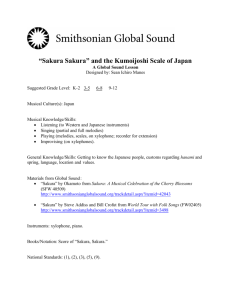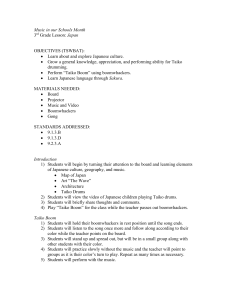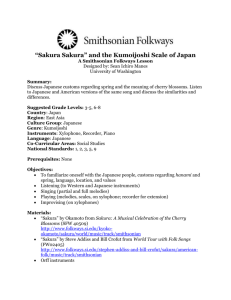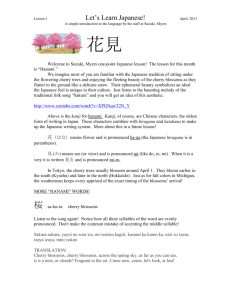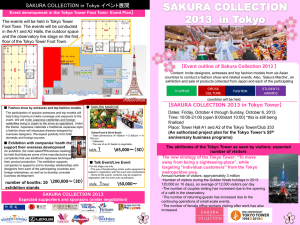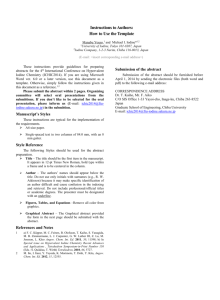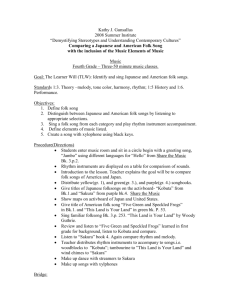Multicultural Project - Japanese Music Lesson
advertisement
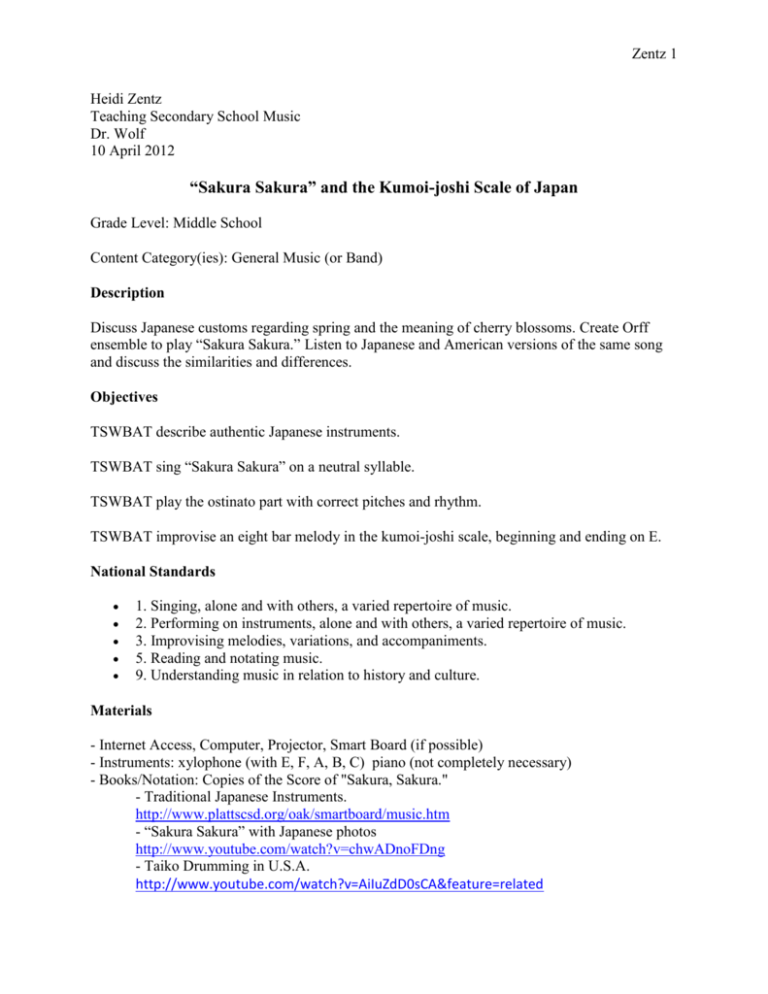
Zentz 1 Heidi Zentz Teaching Secondary School Music Dr. Wolf 10 April 2012 “Sakura Sakura” and the Kumoi-joshi Scale of Japan Grade Level: Middle School Content Category(ies): General Music (or Band) Description Discuss Japanese customs regarding spring and the meaning of cherry blossoms. Create Orff ensemble to play “Sakura Sakura.” Listen to Japanese and American versions of the same song and discuss the similarities and differences. Objectives TSWBAT describe authentic Japanese instruments. TSWBAT sing “Sakura Sakura” on a neutral syllable. TSWBAT play the ostinato part with correct pitches and rhythm. TSWBAT improvise an eight bar melody in the kumoi-joshi scale, beginning and ending on E. National Standards 1. Singing, alone and with others, a varied repertoire of music. 2. Performing on instruments, alone and with others, a varied repertoire of music. 3. Improvising melodies, variations, and accompaniments. 5. Reading and notating music. 9. Understanding music in relation to history and culture. Materials - Internet Access, Computer, Projector, Smart Board (if possible) - Instruments: xylophone (with E, F, A, B, C) piano (not completely necessary) - Books/Notation: Copies of the Score of "Sakura, Sakura." - Traditional Japanese Instruments. http://www.plattscsd.org/oak/smartboard/music.htm - “Sakura Sakura” with Japanese photos http://www.youtube.com/watch?v=chwADnoFDng - Taiko Drumming in U.S.A. http://www.youtube.com/watch?v=AiIuZdD0sCA&feature=related Zentz 2 - “Sakura Sakura” Score with Lyrics http://erato.uvt.nl/files/imglnks/usimg/e/e7/IMSLP68504-PMLP109485Sakura_sakura_japanese_traditional.pdf - “Sakura Sakura” Score with Colored Noteheads http://petrucci.mus.auth.gr/imglnks/usimg/2/21/IMSLP114906-PMLP109485Sakura_sakura_color.pdf - “Sakura Sakura” Score http://petrucci.mus.auth.gr/imglnks/usimg/1/1c/IMSLP63817-PMLP109485Sakura_Sakura.pdf - Addiss & Crofut 1968 version on koto (2:11) http://www.youtube.com/watch?v=utLSw03D8eA Prior Knowledge Reading music (melody line) Procedures Motivation & Input: 1. Play recording of "Sakura" (http://www.youtube.com/watch?v=chwADnoFDng); ask students to tap lightly with the beat if they can and try to figure out where the song might be from (only the first 60-90 seconds of the track is sufficient). 2. Briefly have students share their thoughts of the listening example by discussing where the song might be from, why it might be from a given location, what specifically in the music reminds them where it’s from, etc. 3. State that this is a song from Japan; show pictures of cherry blossoms, and share with them the fond affection that the Japanese feel for the cherry blossom, the annual parties that the Japanese have when the cherry blossoms are in full-bloom; how the cherry blossom blooms for such a short time is an allusion to the brevity of life. 4. Use Smart Board to interact with http://homeworkhelper.ca/jmi/lice.swf - Traditional Japanese Instruments. Read descriptions of the four Japanese instruments (Shakuhachi, Shamisen, Taiko, Koto) and listen to excerpts. 5. Watch YouTube Clip of Taiko Drumming Ensembles in the U.S.A. (8:15) http://www.youtube.com/watch?v=AiIuZdD0sCA&feature=related 6. Listen to “Sakura Sakura” again. How many students have heard it before? 7. Inform students that this song is written using a Japanese scale called the "kumoi-joshi" scale, which is made up of the pitches E, F, A, B, C. 8. Hand out score and teach the song to the students on a neutral syllable (unless time to learn the Japanese) - (use a version that does not use a "D" in the last phrase if written in A minor). Zentz 3 *9. Teach bass xylophones the ostinato that is E-B-E’ over 2 beats (2 eighths followed by quarter) (Have extraneous pitches (G and D) removed from the Orff instruments beforehand.) 10. (Teacher) Sing the piece on a neutral syllable over the ostinato. Students, follow along in the score. *11. Have the class sing gently over the ostinato. (Switch out ostinato players now if necessary to give multiple students in the class a chance to play.) *11. Isolate the first two phrases (1st four measures) and ask students in groups of 3-4 to "figure out" what the notes might be using the instruments. Remind them that the pitches on the xylos that are missing are not necessary to play this song. (A,A,B – A,A,B – A,B,C,B- A, B,A, F) *12. Invite students to improvise an 8-beat pattern, beginning and ending on the pitch "E"; give students one minute to figure out what they might want to do individually (or, in pairs). *13. Have each individual student/pair exhibit their "improvisation." 14. Play the Steve Addiss and Bill Crofut version of "Sakura" (http://www.youtube.com/watch?v=utLSw03D8eA – 0:00 - 2:11) to the class 15. Briefly discuss how these two Americans have "changed" the song from how it was performed on the koto in the original recording (a portion of the "original" may be replayed, if desired); how the Japan-inspired work on the recording is similar and/or different from the class’s Japan-inspired creation from today’s lesson. *16.What authentic Japanese instruments do you hear? Briefly discuss how music from a different part of a world can inspire musicians to create something very different from what they’re "used to," just like our activity today created something that is a little bit different than usual. Extension: Create an Orff-inspired arrangement of "Sakura" using xylophones, recorders (using both a melody and a counter melody), and singing, and perform it at a concert. Assessment * Assess students during activities for successful achievement of objectives. Supplemental Resources http://www.smithsonianglobalsound.org/images/teaching/SakuraJapan.pdf http://www.smithsonianglobalsound.org Source Lesson Plan adapted from Sean Ichiro Manes: A Smithsonian Global Sound Lesson http://www.menc.org/lessons/view/642/ - Sakura Lesson Plan on MENC Website
